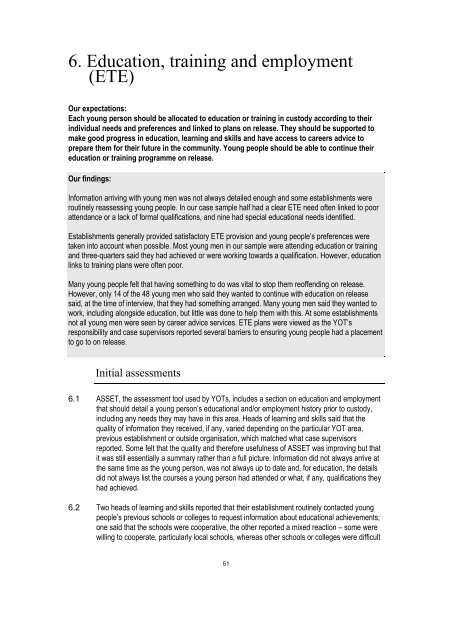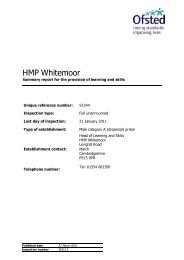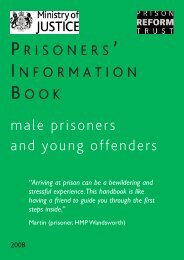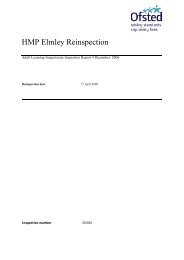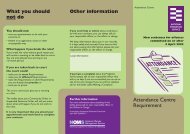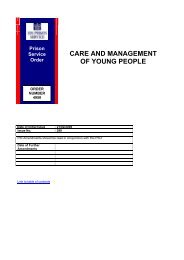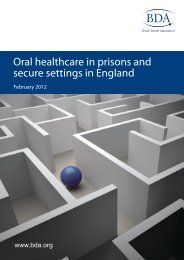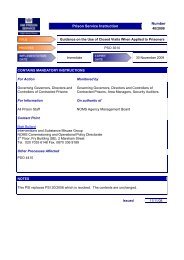Resettlement provision for children and young ... - Ministry of Justice
Resettlement provision for children and young ... - Ministry of Justice
Resettlement provision for children and young ... - Ministry of Justice
You also want an ePaper? Increase the reach of your titles
YUMPU automatically turns print PDFs into web optimized ePapers that Google loves.
6. Education, training <strong>and</strong> employment<br />
(ETE)<br />
Our expectations:<br />
Each <strong>young</strong> person should be allocated to education or training in custody according to their<br />
individual needs <strong>and</strong> preferences <strong>and</strong> linked to plans on release. They should be supported to<br />
make good progress in education, learning <strong>and</strong> skills <strong>and</strong> have access to careers advice to<br />
prepare them <strong>for</strong> their future in the community. Young people should be able to continue their<br />
education or training programme on release.<br />
Our findings:<br />
In<strong>for</strong>mation arriving with <strong>young</strong> men was not always detailed enough <strong>and</strong> some establishments were<br />
routinely reassessing <strong>young</strong> people. In our case sample half had a clear ETE need <strong>of</strong>ten linked to poor<br />
attendance or a lack <strong>of</strong> <strong>for</strong>mal qualifications, <strong>and</strong> nine had special educational needs identified.<br />
Establishments generally provided satisfactory ETE <strong>provision</strong> <strong>and</strong> <strong>young</strong> people’s preferences were<br />
taken into account when possible. Most <strong>young</strong> men in our sample were attending education or training<br />
<strong>and</strong> three-quarters said they had achieved or were working towards a qualification. However, education<br />
links to training plans were <strong>of</strong>ten poor.<br />
Many <strong>young</strong> people felt that having something to do was vital to stop them re<strong>of</strong>fending on release.<br />
However, only 14 <strong>of</strong> the 48 <strong>young</strong> men who said they wanted to continue with education on release<br />
said, at the time <strong>of</strong> interview, that they had something arranged. Many <strong>young</strong> men said they wanted to<br />
work, including alongside education, but little was done to help them with this. At some establishments<br />
not all <strong>young</strong> men were seen by career advice services. ETE plans were viewed as the YOT’s<br />
responsibility <strong>and</strong> case supervisors reported several barriers to ensuring <strong>young</strong> people had a placement<br />
to go to on release.<br />
Initial assessments<br />
6.1 ASSET, the assessment tool used by YOTs, includes a section on education <strong>and</strong> employment<br />
that should detail a <strong>young</strong> person’s educational <strong>and</strong>/or employment history prior to custody,<br />
including any needs they may have in this area. Heads <strong>of</strong> learning <strong>and</strong> skills said that the<br />
quality <strong>of</strong> in<strong>for</strong>mation they received, if any, varied depending on the particular YOT area,<br />
previous establishment or outside organisation, which matched what case supervisors<br />
reported. Some felt that the quality <strong>and</strong> there<strong>for</strong>e usefulness <strong>of</strong> ASSET was improving but that<br />
it was still essentially a summary rather than a full picture. In<strong>for</strong>mation did not always arrive at<br />
the same time as the <strong>young</strong> person, was not always up to date <strong>and</strong>, <strong>for</strong> education, the details<br />
did not always list the courses a <strong>young</strong> person had attended or what, if any, qualifications they<br />
had achieved.<br />
6.2 Two heads <strong>of</strong> learning <strong>and</strong> skills reported that their establishment routinely contacted <strong>young</strong><br />
people’s previous schools or colleges to request in<strong>for</strong>mation about educational achievements;<br />
one said that the schools were cooperative, the other reported a mixed reaction – some were<br />
willing to cooperate, particularly local schools, whereas other schools or colleges were difficult<br />
51


